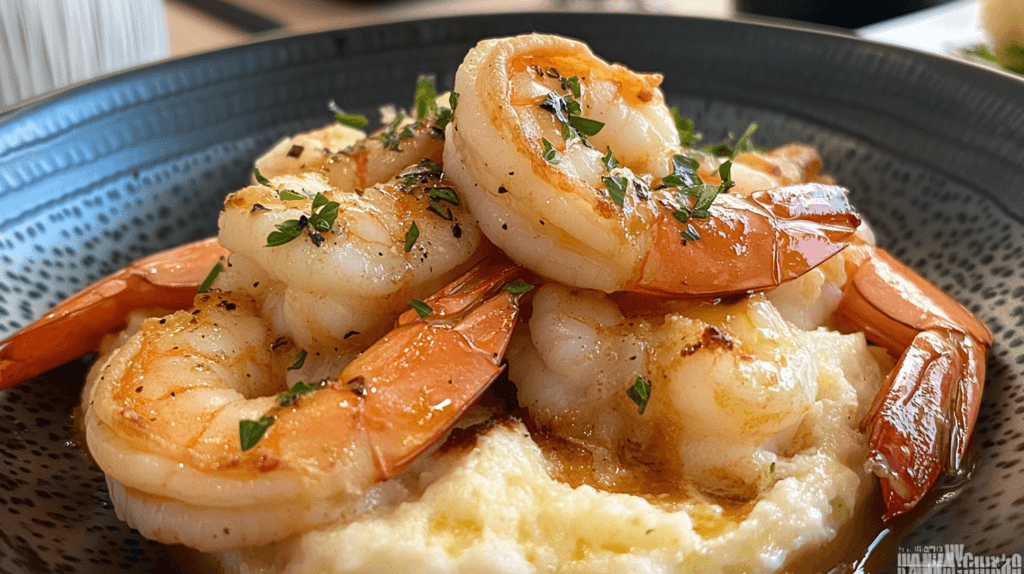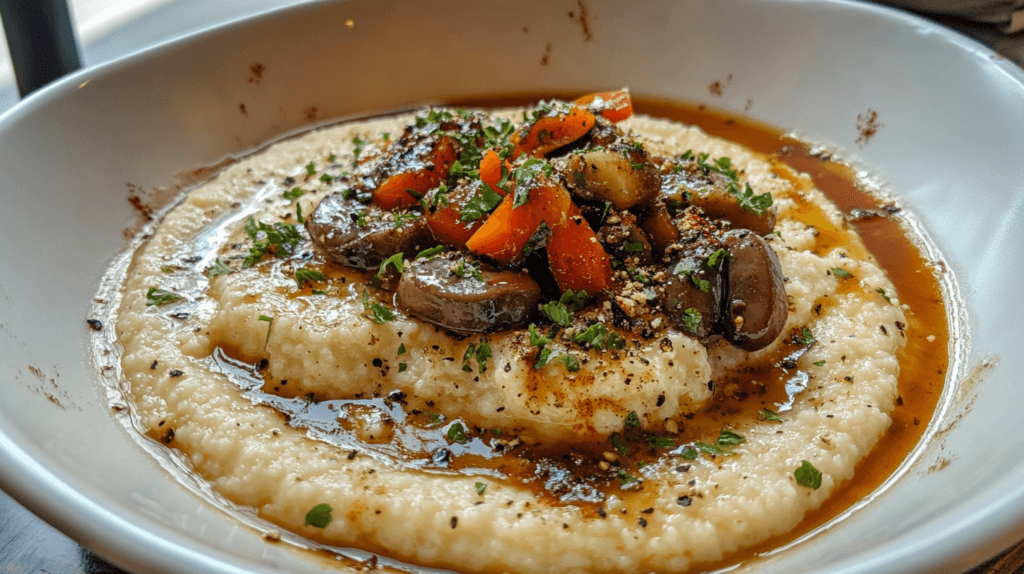Are grits gluten-free? If you follow a gluten-free diet due to celiac disease, gluten intolerance, or personal choice, you may wonder if grits are safe to eat. Grits are a beloved staple in Southern cuisine, known for their creamy texture and versatility. Since they are made from corn, which is naturally gluten-free, grits should be safe for those avoiding gluten. However, the real concern lies in cross-contamination during processing.
In this article, we’ll explore whether grits are truly gluten-free, how they are processed, what to look for when buying them, and how to safely enjoy them in your diet. Let’s break it all down so you can enjoy this comforting dish worry-free!
Table of Contents
What Are Grits?
Definition and History
Grits are made from dried corn that has been ground into coarse granules. This dish has deep roots in Native American cuisine and has since become a cornerstone of Southern cooking. Traditionally, grits are simmered with water or milk to create a creamy, porridge-like consistency. Depending on personal preferences or regional variations, they may be served sweet, savory, or as a side dish to complement other meals.
Types of Grits
Not all grits are created equal, and understanding the different types is key to determining their gluten-free status.
- Stone-Ground Grits: These are the least processed type of grits, made by grinding whole dried corn kernels between stone wheels. Stone-ground grits often have a more coarse texture and robust flavor.
- Instant or Quick Grits: These are pre-cooked and dried to reduce cooking time, making them a convenient choice. However, their processing may expose them to cross-contamination with gluten-containing grains.
- Hominy Grits: These are made from corn kernels treated with an alkali solution to remove the hull and germ. The result is a softer texture and slightly different flavor compared to regular grits.
Are Grits Gluten-Free?
The Core Ingredient: Corn
The primary ingredient in grits is corn, which is naturally gluten-free. Unlike wheat, barley, and rye, corn does not contain gluten proteins that can trigger adverse reactions in those with celiac disease or gluten sensitivity. So, in their pure form, grits should be safe for a gluten-free diet.
Cross-Contamination During Processing
While corn itself is gluten-free, the processing of grits can pose risks. Cross-contamination often occurs when grits are processed in facilities that also handle gluten-containing grains like wheat, barley, or rye. Even trace amounts of gluten can make a product unsafe for those with celiac disease or severe sensitivities.
To avoid this, it’s essential to look for grits labeled “certified gluten-free,” as these products are produced in facilities with strict measures to prevent cross-contamination.
Different Types of Grits and Gluten-Free Status
Stone-Ground Grits
Stone-ground grits are generally gluten-free if processed in a dedicated facility. However, because they are minimally processed, they are more likely to come from small-scale producers who may not label them as gluten-free. Always check the packaging or contact the manufacturer for confirmation.
Instant or Quick Grits
Instant and quick grits are highly processed, and there’s a greater chance of cross-contamination due to shared equipment in large-scale factories. Opt for brands that explicitly state their products are gluten-free to ensure safety.
Hominy Grits
Hominy grits are also made from corn and are naturally gluten-free. However, as with other types, the risk lies in the manufacturing process. Look for certified gluten-free hominy grits if you have gluten sensitivity or celiac disease.
Gluten-Free Labeling: What to Look For
Certified Gluten-Free Products
When shopping for grits, the safest bet is to look for products labeled as “certified gluten-free.” Certification means the product has undergone testing and meets strict standards to ensure it contains less than 20 parts per million (ppm) of gluten, which is considered safe for most individuals with gluten intolerance.
Understanding Gluten-Free Standards
Some products may be labeled “gluten-free” without certification. While this is helpful, it’s always best to choose certified products when possible, especially if you have celiac disease. Familiarize yourself with trustworthy gluten-free certification organizations, such as the Gluten-Free Certification Organization (GFCO).
How Are Grits Processed?
Potential Gluten Cross-Contamination in Factories
The risk of gluten contamination occurs most often during processing. Factories that produce multiple grain-based products may use the same equipment for corn grits and gluten-containing grains like wheat or barley. Shared equipment increases the likelihood of cross-contamination, making the product unsafe for those on a strict gluten-free diet.
Ensuring a Safe Gluten-Free Supply Chain
Some manufacturers take extra precautions to ensure their grits remain gluten-free. This includes using dedicated equipment, regularly testing for gluten, and adhering to strict production protocols. Always research the brand or contact the company if you’re unsure about their processing methods.
Popular Gluten-Free Grits Brands
Trusted Manufacturers Offering Certified Products
Several brands prioritize gluten-free production, making it easier to find safe grits. Some trusted names include:
- Bob’s Red Mill: Known for their certified gluten-free products, including stone-ground grits.
- Arrowhead Mills: Offers organic grits that are processed in gluten-free facilities.
- Quaker: While not all Quaker grits are gluten-free, the company provides clear labeling on products that are safe for those with gluten sensitivities.
Key Features to Consider When Buying
When purchasing grits, look for these features:
- “Certified Gluten-Free” labels for maximum assurance.
- Minimal ingredients—just corn and maybe a pinch of salt.
- Organic or non-GMO options, if that’s important to you.
Nutritional Benefits of Grits
Macronutrient Composition
Grits are a carbohydrate-rich food, making them a great source of energy. A single serving (about one cup of cooked grits) provides approximately:
- Carbohydrates: 24-30 grams, depending on the type.
- Protein: 3-4 grams, which helps support muscle repair and growth.
- Fiber: 1-2 grams, especially in whole-grain stone-ground grits.
Grits are naturally low in fat and sugar, which makes them a healthy option for many diets when prepared without heavy butter or cream.
Key Vitamins and Minerals
Grits also offer an impressive range of essential nutrients, including:
- Iron: Supports oxygen transport in the blood, helping to combat fatigue.
- B Vitamins: Niacin, thiamine, and riboflavin help convert food into energy.
- Folate: Especially important for pregnant women to support fetal development.
- Magnesium and Zinc: Essential minerals for immune function and bone health.
By incorporating grits into your diet, you can enjoy these nutritional benefits while maintaining a gluten-free lifestyle.
Can Grits Fit Into a Gluten-Free Diet?
Benefits of Including Grits
Grits are an excellent choice for those on a gluten-free diet for several reasons:
- Naturally Gluten-Free: Corn, the main ingredient, is safe for those with gluten sensitivities.
- Versatility: Grits can be paired with a variety of ingredients, from savory shrimp to sweet fruits.
- Affordable and Accessible: Grits are widely available in grocery stores and are often budget-friendly.
Tips for Safe Preparation
To avoid accidental gluten exposure when preparing grits:
- Use clean cookware and utensils free from gluten residue.
- Prepare grits in a gluten-free kitchen or thoroughly clean shared surfaces before cooking.
- Check added ingredients, such as broths or seasonings, for hidden gluten.
Recipes for Gluten-Free Grits

Breakfast Recipe: Grits with Eggs and Cheese
This simple recipe is a hearty, gluten-free breakfast option:
- Cook one cup of certified gluten-free grits with water or milk according to package instructions.
- Stir in shredded cheddar cheese for a creamy texture.
- Top with a fried or poached egg for added protein.
- Season with salt, pepper, and optional fresh herbs.
Savory Recipe: Shrimp and Grits
Shrimp and grits is a Southern classic that can easily be made gluten-free:
- Prepare one cup of grits with water, adding a pat of butter and salt for flavor.
- In a separate pan, sauté shrimp with garlic, smoked paprika, and gluten-free hot sauce.
- Serve the shrimp over the grits, garnished with green onions or parsley.
These recipes are not only gluten-free but also flavorful and satisfying!
Are There Gluten-Free Alternatives to Grits?
Polenta
Polenta, like grits, is made from corn and is naturally gluten-free. The primary difference is the type of corn used—polenta uses yellow corn, while grits typically use white corn. Polenta is an excellent substitute for grits and can be served soft or firm.
Quinoa
If you’re looking for a gluten-free alternative with a higher protein content, quinoa is a great choice. Its nutty flavor and versatility make it a suitable substitute for grits in both sweet and savory dishes.
Other options include mashed cauliflower or rice porridge for those who want to mix things up while avoiding gluten.
Frequently Asked Questions (FAQs)
Are Grits Safe for Celiac Patients?
Yes, grits made from pure corn are safe for celiac patients, as long as they are labeled certified gluten-free to avoid cross-contamination.
Are Flavored or Packaged Grits Gluten-Free?
Not always. Flavored or packaged grits often contain added seasonings, thickeners, or preservatives that may include gluten. Always check the ingredient list and look for gluten-free certification.
Can Grits Be Contaminated With Gluten at Restaurants?
Yes, this is a possibility. Restaurants may prepare grits in shared pots or with ingredients containing gluten, such as broths or seasonings. If dining out, ask about preparation methods to ensure the dish is gluten-free.
What’s the Difference Between Grits and Polenta?
The main difference lies in the type of corn and the texture. Grits use white corn and are typically coarser, while polenta uses yellow corn and has a finer consistency. Both are naturally gluten-free and closely related to foods like corn tortillas.
Can I Eat Grits on a Low-Carb Diet?
Traditional grits are high in carbohydrates, so they may not fit into a strict low-carb diet. However, cauliflower-based “grits” are a great low-carb alternative.
Conclusion
In summary, grits can be a delicious and gluten-free option for your diet when chosen carefully. Corn, the primary ingredient in grits, is naturally gluten-free, but cross-contamination during processing is a potential concern. To ensure safety, always opt for certified gluten-free brands and follow proper preparation practices. Whether you enjoy grits as a breakfast dish, a comforting dinner side, or the star of your meal, you can savor their creamy texture and versatility without worrying about gluten. Explore other corn-based recipes, like Southern Cornbread, or check out gluten-free dinner recipes for more ideas!
Printable Recipe Card
Want just the essential recipe details without scrolling through the article? Get our printable recipe card with just the ingredients and instructions.

